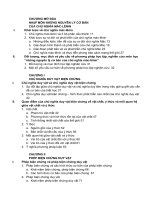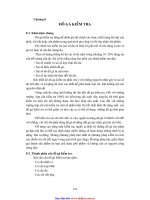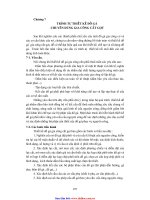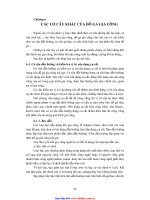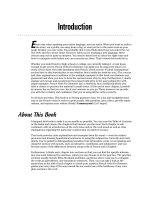Giáo trình động từ tiếng Pháp - Part II Using Verbs Correctly with Questions, Commands, and Such - Chapter 8 pdf
Bạn đang xem bản rút gọn của tài liệu. Xem và tải ngay bản đầy đủ của tài liệu tại đây (317.99 KB, 12 trang )
Chapter 8
Telling People What to Do: The Regular,
Irregular, and Pronominal Commands
In This Chapter
ᮣ Forming the imperative with regular and irregular verbs
ᮣ Making the imperative negative
ᮣ Including pronominal verbs in a command
ᮣ Putting pronouns in the mix to make commands
H
ow do you tell people what to do, like bring you coffee, clean your house, go to the
market, or even leave? You can tell people to do all these things and more by using
the imperative mood, more commonly known as the command.
This chapter shows you how to transform regular, irregular, and pronominal verbs into com-
mands as well as how to create negative commands. Then I show you how to add pronouns
to your commands.
Forming Commands with Regular Verbs
The technical term for giving commands or orders is the imperative. In this chapter, I use
the terms interchangeably. You give orders in English as well as in French by using the
verb directly and eliminating the subject pronoun. For example, you may say
Set the table,
Wash the dishes,
and so on. In the following sections, I show you how to form commands
with regular verbs.
Making -er verbs into commands
The commands come from the tu, nous, and vous forms of the present tense. Note that the
subject pronouns are never used in the command, just their verb forms. In English, you
don’t command someone by saying
You speak. Instead, you simply say Speak! It’s the same
in French.
For all
-er verbs (as well as the irregular verb aller [to go]), you drop the s from the tu form
in the imperative.
This rule also applies to irregular
-ir verbs, which are conjugated like regular -er verbs —
like
ouvrir (to open), souffrir (to suffer), and offrir (to offer). The s reappears when the verb
is followed by the pronouns
y or en for pronunciation reasons. Examples include Parles-en!
(Speak about it!), Vas-y! (Go there!), and Offres-en! (Offer some!). However, the s is dropped
in the imperative negative:
N’en parle pas (Don’t speak about it!), N’y va pas! (Don’t go there!),
and
N’en offre pas! (Don’t offer any!). The nous and vous forms don’t have any changes.
13_773883 ch08.qxp 8/2/06 1:29 PM Page 89
Use the tu command when speaking to one person with whom you’re familiar. You use
the
vous command when speaking to one person with whom you aren’t familiar, a
superior (like your boss or your professor), or someone older than you; and when
you’re speaking to more than one person. When you use the nous command, you’re
including yourself in the group. For example,
Allons au centre commercial (Let’s go
to the mall
).
Take a look at the verb
parler (to speak) in Table 8-1 as an example of -er verbs.
Table 8-1 Parler (
to speak
) in the Imperative Form
Present Tense Imperative Form
Tu parles Parle! (
Speak!
)
Nous parlons Parlons! (
Let’s speak!
)
Vous parlez Parlez! (
Speak!
)
Try putting some regular -er verbs in their three imperative forms: tu, nous, and vous.
Check out the example problem first.
Q. Chanter (to sing) _________________ _________________ _________________
A. Chante! (Sing!), Chantons! (Let’s sing!), Chantez! (Sing!)
1. Arrêter (to stop) _________________ _________________ _________________
2. Regarder (to watch) _________________ _________________ _________________
3. Écouter (to listen) _________________ _________________ _________________
4. Décider (to decide) _________________ _________________ _________________
5. Répéter (to repeat) _________________ _________________ _________________
Making -ir verbs into commands
Regular -ir verbs follow the same pattern in commands as the verbs that end in -er.
You use the tu, nous, and vous forms of the verbs without the subject pronouns.
Unlike the
-er verbs, however, you don’t drop the s from the verb in the tu form.
Check out Table 8-2 for an example of
-ir verbs in the imperative.
Table 8-2 Finir (
to finish
) in the Imperative Form
Present Tense Imperative Form
Tu finis Finis! (
Finish!
)
Nous finissons Finissons! (
Let’s finish!
)
Vous finissez Finissez! (
Finish!
)
90
Part II: Using Verbs Correctly with Questions, Commands, and Such
13_773883 ch08.qxp 8/2/06 1:29 PM Page 90
Put the following -ir verbs in the imperative form. For each question, write out the tu,
nous,
and vous forms.
Q. Réunir (to reunite) _________________ _________________ _________________
A. Réunis! (Reunite!), Réunissons! (Let’s reunite!), Réunissez! (Reunite!)
6. Choisir (to choose) _________________ _________________ _________________
7. Réfléchir (to think) _________________ _________________ _________________
8. Obéir (to obey) _________________ _________________ _________________
9. Applaudir (to applaud) _________________ _________________ _________________
10. Réussir (to succeed) _________________ _________________ _________________
Making -re verbs into commands
The -re verbs are no different than the -ir and -re verbs in the command form. Just
take the
tu, nous, and vous forms of the present tense and drop the subject pro-
nouns. Take a look at Table 8-3 for an example
-re verb.
Table 8-3 Attendre (
to wait
) in the Imperative Form
Present Tense Imperative Form
Tu attends Attends! (
Wait!
)
Nous attendons Attendons! (
Let’s wait!
)
Vous attendez Attendez! (
Wait!
)
Try putting regular -re verbs in their imperative tu, nous, and vous forms.
Q. Défendre (to defend) _________________ _________________ _________________
A. Défends! (Defend!), Défendons! (Let’s defend!), Défendez! (Defend!)
11. Descendre (to go downstairs) _________________ _________________ _________________
12. Répondre (to answer) _________________ _________________ _________________
13. Vendre (to sell) _________________ _________________ _________________
14. Rendre (to give back) _________________ _________________ _________________
15. Entendre (to hear) _________________ _________________ _________________
91
Chapter 8: Telling People What to Do: The Regular, Irregular, and Pronominal Commands
13_773883 ch08.qxp 8/2/06 1:29 PM Page 91
Forming Commands with Irregular Verbs
Irregular verbs work exactly the same way as regular verbs (see the previous sec-
tion). All you have to worry about is remembering the conjugation of the irregular
verbs and you can put them in the
tu, nous, and vous forms. (You can find the conju-
gation of the irregular verbs in Chapter 4.) Check out the examples in Table 8-4 and
Table 8-5.
Table 8-4 Prendre (
to take
) in the Imperative Form
Present Tense Imperative Form
Tu prends Prends! (
Take!
)
Nous prenons Prenons! (
Let’s take!
)
Vous prenez Prenez! (
Take!
)
Table 8-5 Lire (
to read
) in the Imperative Form
Present Tense Imperative Form
Tu lis Lis! (
Read!
)
Nous lisons Lisons! (
Let’s read!
)
Vous lisez Lisez! (
Read!
)
As you can see, even most irregular verbs have the same pattern as the regular verbs.
That is, you use their
tu, nous, and vous present tense verb forms, minus the subject
pronouns. Try putting the following verbs in the imperative form.
Q. Écrire (to write) _________________ _________________ _________________
A. Écris! (Write!), Écrivons! (Let’s write!), Écrivez! (Write!)
16. Faire (to do, to make) _________________ _________________ _________________
17. Aller (to go) _________________ _________________ _________________
18. Sortir (to go out) _________________ _________________ _________________
19. Venir (to come) _________________ _________________ _________________
20. Dormir (to sleep) _________________ _________________ _________________
Four irregular verbs, however, also have irregular imperative forms, which are not the
same as their present tenses. Check out Tables 8-6, 8-7, 8-8, and 8-9 to see these verbs.
92
Part II: Using Verbs Correctly with Questions, Commands, and Such
13_773883 ch08.qxp 8/2/06 1:29 PM Page 92
Table 8-6 Avoir (
to have
) in the Imperative Form
Present Tense Imperative Form
Tu as Aie! (
Have . . .!
)
Nous avons Ayons! (
Let’s have . . .!
)
Vous avez Ayez! (
Have . . .!
)
Table 8-7 Être (
to be
) in the Imperative Form
Present Tense Imperative Form
Tu es Sois! (
Be . . .!
)
Nous sommes Soyons! (
Let’s be . . .!
)
Vous êtes Soyez! (
Be . . .!
)
Table 8-8 Savoir (
to know
) in the Imperative Form
Present Tense Imperative Form
Tu sais Sache! (
Know . . .!
)
Nous savons Sachons! (
Let’s know . . .!
)
Vous savez Sachez! (
Know . . .!
)
Table 8-9 Vouloir (
to want
) in the Imperative Form
Present Tense Imperative Form
Tu veux Veuille! (
Please . . .!
)
Nous voulons Veuillons! (
Please . . .!
)
Vous voulez Veuillez! (
Please . . .!
)
For the verb vouloir, you mostly use the veuillez form when giving commands, and
you usually follow it with the infinitive. This word is a polite way to give commands
and is often translated as
please, as it is with Veuillez entrer (Please come in) and
Veuillez me suivre (Please follow me).
Put the following verbs in their imperative forms for the subject pronoun indicated in
parentheses.
Q. Fermer la porte. (nous)
A. Fermons la porte! (Let’s close the door!)
93
Chapter 8: Telling People What to Do: The Regular, Irregular, and Pronominal Commands
13_773883 ch08.qxp 8/2/06 1:29 PM Page 93
21. Être gentil. (tu)
__________________________________________________________________________________
22.
Obéir à tes parents. (tu)
__________________________________________________________________________________
23.
Manger. (nous)
__________________________________________________________________________________
24.
Faire vos devoirs. (vous)
__________________________________________________________________________________
25.
Avoir de la patience. (tu)
__________________________________________________________________________________
Creating the Negative Imperative
What if you want to tell people not to do something? Imagine telling your little sister,
your child, or even your dog not to do something. For example, you tell them don’t
yell, don’t run, and don’t touch. This section shows you how to use the negative com-
mand. In order to use the negative command, just add
ne before the imperative form
and
pas or any other negative expression after the imperative form. (For more on the
negative, look at Chapter 7.) Check out the following examples.
Ne parle pas! (Don’t speak!)
Ne parlons pas! (Let’s not speak!)
If the verb begins with a vowel or a mute
h, drop the e from ne and add an
apostrophe.
N’attends pas! (Don’t wait!)
N’attendons pas! (Let’s not wait!)
Note that when the infinitive is negative, the ne and pas are placed together and they
precede the infinitive.
Veuillez ne pas fumer! (Please don’t smoke!)
Veuillez ne pas toucher! (Please don’t touch!)
Put the following verbs in the negative imperative for the
tu, nous, or vous form, as
indicated in parentheses.
Q. Ne pas venir. (vous) __________________________________
A. Ne venez pas! (Don’t come!)
26. Ne pas commencer les devoirs. (nous)
__________________________________________________________________________________
94
Part II: Using Verbs Correctly with Questions, Commands, and Such
13_773883 ch08.qxp 8/2/06 1:29 PM Page 94
27. Ne pas dormir. (tu)
__________________________________________________________________________________
28.
Ne pas mettre les pieds sur la table. (tu)
__________________________________________________________________________________
29.
Ne pas aller au magasin. (nous)
__________________________________________________________________________________
30.
Ne pas téléphoner à Marc. (tu)
__________________________________________________________________________________
Using Pronominal Verbs to Make Commands
You eliminate the subject pronouns in the imperative form, but you still have to keep
the pronominal pronouns when you’re working with pronominal verbs (see Chapter 5
for the lowdown on pronominal verbs). In the affirmative imperative, the pronominal
pronouns follow a verb-hyphen combination. In the negative imperative, the pronomi-
nal pronouns precede the verb.
Note: Ne precedes the pronouns and pas follows the
verb. Check out the following example in Table 8-10.
Table 8-10 Se Lever (
to get up
) in the Imperative Form
Present Tense Affirmative Imperative Negative Imperative
Tu te lèves Lève-toi! (
Get up!
) Ne te lève pas! (
Don’t get up!
)
Nous nous levons Levons-nous! (
Let’s get up!
) Ne nous levons pas! (
Let’s not get up!
)
Vous vous levez Levez-vous! (
Get up!
) Ne vous levez pas! (
Don’t get up!
)
Note that the pronominal pronoun te becomes toi in the imperative affirmative but
then returns to being
te in the negative. If the verb begins with a vowel or a mute h,
drop the e from te and add an apostrophe. An example is the verb s’habiller (to get
dressed
), which you can see in Table 8-11. (Both se lever and s’habiller are -er verbs,
so remember to drop the
s from the tu form of their present conjugation.)
Table 8-11 S’habiller (
to get dressed
) in the Imperative Form
Present Tense Affirmative Imperative Negative Imperative
Tu t’habilles Habille-toi! Ne t’habille pas!
(
Get dressed!
)(
Don’t get dressed!
)
Nous nous habillons Habillons-nous! Ne nous habillons pas!
(
Let’s get dressed!
)(
Let’s not get dressed!
)
Vous vous habillez Habillez-vous! Ne vous habillez pas!
(
Get dressed!
)(
Don’t get dressed!
)
95
Chapter 8: Telling People What to Do: The Regular, Irregular, and Pronominal Commands
13_773883 ch08.qxp 8/2/06 1:29 PM Page 95
Now it’s your turn. Put the following pronominal verbs in the three imperative forms,
first in the affirmative and then in the negative.
Q. Se maquiller (to put on makeup)
A. (tu) Maquille-toi! (Put on makeup!), Ne te maquille pas! (Don’t put on makeup!)
(nous)
Maquillons-nous! (Let’s put on makeup!), Ne nous maquillons pas! (Let’s not put
on makeup!
)
(vous)
Maquillez-vous! (Put on makeup!), Ne vous maquillez pas! (Don’t put on makeup!)
31. Se coucher (to go to bed)
(tu) _________________ _________________
(nous) _________________ _________________
(vous) _________________ _________________
32. Se réveiller (to wake up)
(tu) _________________ _________________
(nous) _________________ _________________
(vous) _________________ _________________
33. Se laver (to get washed)
(tu) _________________ _________________
(nous) _________________ _________________
(vous) _________________ _________________
34. Se brosser les dents (to brush one’s teeth)
(tu) _________________ _________________
(nous) _________________ _________________
(vous) _________________ _________________
35. Se raser (to shave)
(tu) _________________ _________________
(nous) _________________ _________________
(vous) _________________ _________________
Adding Pronouns to Commands
If you want to add pronouns to commands, with comments such as take it, give it to
us,
or offer her some, use the verb in the imperative affirmative and then the pronoun,
and you join the two with a hyphen. Use the following order separated by hyphens:
96
Part II: Using Verbs Correctly with Questions, Commands, and Such
13_773883 ch08.qxp 8/2/06 1:29 PM Page 96
Verb in the imperative- + direct object- + indirect object- + y- + en
You never use all these pronouns at once, but you often use two of them, and this
chart shows the order you use them in. For example, to say
give it to her, put the verb
in the imperative, add a hyphen, the direct object, another hyphen, and the indirect
object, like so:
Donne-le-lui!
Before you practice adding pronouns to commands, you need to know the direct and
indirect object pronouns. Table 8-12 lists them with their English counterparts.
Table 8-12 Direct and Indirect Object Pronouns
Direct Object Direct Object Indirect Object Indirect Object
Pronoun (English) Pronoun (French) Pronoun (English) Pronoun (French)
me me to me me
you te to you te
him/it (masculine singular) le to him lui
her/it (feminine singular) la to her lui
us nous to us nous
you vous to you vous
them les to them leur
In the negative command, the ne precedes the pronoun or pronouns and the pas or
another negative word follows the verb in the command form. Check out the follow-
ing examples of affirmative and negative imperatives with direct and indirect object
pronouns.
Parle-lui! (Speak to him/her!), Ne lui parle pas! (Don’t speak to him/her!)
Finis-le! (Finish it!), Ne le finis pas! (Don’t finish it!)
Commençons-la! (Let’s begin it!), Ne la commençons pas! (Let’s not begin it!)
Écrivez-nous! (Write to us!), Ne nous écrivez pas! (Don’t write to us!)
The following are examples of both direct and indirect objects together. Note that the
direct object precedes the indirect object and that
me and te change to moi and toi
when they’re at the end of the imperative construction. In the negative, however, they
go back to
me and te. Note: You usually never have more than two pronouns in a sen-
tence, but Figure 8-1 shows the order the pronouns come in.
Donnez-les-moi! (Give them to me!), Ne me les donnez pas! (Don’t give them to me!)
Envoyons-le-leur! (Let’s send it to them!), Ne le leur envoyons pas! (Let’s not send
it to them!
)
Vends-les-nous! (Sell them to us!), Ne nous les vends pas! (Don’t sell them to us!)
ne + +
me
te
se
nous
vous
le
la
les
+
lui
leur
+y+en+verb + pas
Figure 8-1:
The order of
pronouns for
the negative
commands.
97
Chapter 8: Telling People What to Do: The Regular, Irregular, and Pronominal Commands
13_773883 ch08.qxp 8/2/06 1:29 PM Page 97
The pronoun y means there or in it and is a pronoun of place. It replaces phrases
starting with prepositions of place such as
à, en, dans, sur, sous, and à + noun
(things, not people). For example, à + la musique means in music in the sentence Je
m’intéresse à la musique
(I am interested in music). You replace à la musique with y.
The pronoun en replaces the prepositions de, du, de l’, and des + noun, and it means
some, any, from there, or of them, depending on what it’s replacing.
Offres-en! (Offer some!), N’en offre pas! (Don’t offer any!)
Prends-en! (Take some!), N’en prends pas! (Don’t take any!)
Allons-y! (Let’s go [there]!), N’y allons pas! (Let’s not go [there]!)
Don’t forget to add the
s to the tu form of -er verbs if the pronoun begins with a vowel
and the verb ends in a vowel. However, in the negative, the
s is dropped.
Entres-y! (Enter [there]!), N’y entre pas! (Don’t enter [there]!)
Check out these examples with more added pronouns.
Mets-les-y! (Put them there!), Ne les y mets pas! (Don’t put them there!)
Parlez-lui-en! (Speak to him/her about it!), Ne lui en parlez pas! (Don’t speak to
him/her about it!
)
Place-l’y! (Place it there!), Ne l’y place pas! (Don’t place it there!)
Translate the following sentences by putting the verb in the imperative form and
adding the appropriate pronouns by looking at Table 8-12. (Remember that some
verbs are transitive in French but intransitive in English and vice versa, so check out
Chapter 1 if you need additional help.)
Q. Let’s ask him!
A. Demandons-lui!
36.
Finish them!
__________________________________________________________________________________
37.
Let’s speak to them!
__________________________________________________________________________________
38.
Go there!
__________________________________________________________________________________
39.
Open it!
__________________________________________________________________________________
40.
Close it!
__________________________________________________________________________________
98
Part II: Using Verbs Correctly with Questions, Commands, and Such
13_773883 ch08.qxp 8/2/06 1:29 PM Page 98
99
Chapter 8: Telling People What to Do: The Regular, Irregular, and Pronominal Commands
Answer Key
This section provides the answers for all the problems in this chapter. Compare your
answers to the correct ones. How did you do? Remember that some of these verbs
usually appear with a noun, so the literal translation may appear a bit odd.
a
Arrête! (Stop!), Arrêtons! (Let’s stop!), Arrêtez! (Stop!)
b
Regarde! (Watch!), Regardons! (Let’s watch!), Regardez! (Watch!)
c
Écoute! (Listen!), Écoutons! (Let’s listen!), Écoutez! (Listen!)
d
Décide! (Decide!), Décidons! (Let’s decide!), Décidez! (Decide!)
e
Répète! (Repeat!), Répétons! (Let’s repeat!), Répétez! (Repeat!)
f
Choisis! (Choose!), Choisissons! (Let’s choose!), Choisissez! (Choose!)
g
Réfléchis! (Think!), Réfléchissons! (Let’s think!), Réfléchissez! (Think!)
h
Obéis! (Obey!), Obéissons! (Let’s obey!), Obéissez! (Obey!)
i
Applaudis! (Applaud!), Applaudissons! (Let’s applaud!), Applaudissez! (Applaud!)
j
Réussis! (Succeed!), Réussissons! (Let’s succeed!), Réussissez! (Succeed!)
k
Descends! (Go down [the stairs]!), Descendons! (Let’s go down [the stairs]!), Descendez!
(Go down [the stairs]!)
l
Réponds! (Answer!), Répondons! (Let’s answer!), Répondez! (Answer!)
m
Vends! (Sell!), Vendons! (Let’s sell!), Vendez! (Sell!)
n
Rends! (Give back!), Rendons! (Let’s give back!), Rendez! (Give back!)
o
Entends! (Hear!), Entendons! (Let’s hear!), Entendez! (Hear!)
p
Fais! (Do!), Faisons! (Let’s do!), Faites! (Do!)
q
Va! (Go!), Allons! (Let’s go!), Allez! (Go!)
r
Sors! (Go out!), Sortons! (Let’s go out!), Sortez! (Go out!)
s
Viens! (Come!), Venons! (Let’s come!), Venez! (Come!)
t
Dors! (Sleep!), Dormons! (Let’s sleep!), Dormez! (Sleep!)
u
Sois gentil! (Be nice!)
v
Obéis à tes parents! (Obey your parents!)
w
Mangeons! (Let’s eat!)
13_773883 ch08.qxp 8/2/06 1:29 PM Page 99
100
Part II: Using Verbs Correctly with Questions, Commands, and Such
x
Faites vos devoirs! (Do your homework!)
y
Aie de la patience! (Have patience!)
A
Ne commençons pas les devoirs! (Let’s not begin the homework!)
B
Ne dors pas! (Don’t sleep!)
C
Ne mets pas les pieds sur la table! (Don’t put your feet on the table!)
D
N’allons pas au magasin! (Let’s not go to the store!)
E
Ne téléphone pas à Marc! (Don’t call Marc!)
F
(tu) Couche-toi! (Go to bed!), Ne te couche pas! (Don’t go to bed!)
(nous)
Couchons-nous! (Let’s go to bed!), Ne nous couchons pas! (Let’s not go to bed!)
(vous)
Couchez-vous! (Go to bed!), Ne vous couchez pas! (Don’t go to bed!)
G
(tu) Réveille-toi! (Wake up!), Ne te réveille pas! (Don’t wake up!)
(nous) Réveillons-nous! (Let’s wake up!), Ne nous réveillons pas! (Let’s not wake up!)
(vous)
Réveillez-vous! (Wake up!), Ne vous réveillez pas! (Don’t wake up!)
H
(tu) Lave-toi! (Wash yourself!), Ne te lave pas! (Don’t wash yourself!)
(nous) Lavons-nous! (Let’s wash ourselves!), Ne nous lavons pas! (Let’s not wash ourselves!)
(vous)
Lavez-vous! (Wash yourself/yourselves!), Ne vous lavez pas! (Don’t wash yourself/
yourselves!
)
I
(tu) Brosse-toi les dents! (Brush your teeth!), Ne te brosse pas les dents! (Don’t brush your teeth!)
(nous)
Brossons-nous les dents! (Let’s brush our teeth!), Ne nous brossons pas les dents!
(Let’s not brush our teeth!)
(vous)
Brossez-vous les dents! (Brush your teeth!), Ne vous brossez pas les dents! (Don’t brush
your teeth!
)
J
(tu) Rase-toi! (Shave!), Ne te rase pas! (Don’t shave!)
(nous)
Rasons-nous! (Let’s shave!), Ne nous rasons pas! (Let’s not shave!)
(vous)
Rasez-vous! (Shave!), Ne vous rasez pas! (Don’t shave!)
K
Finis-les! Or, Finissez-les!
L
Parlons-leur!
M
Vas-y! Or, Allez-y!
N
Ouvre-le/la! Or, Ouvrez-le/la!
O
Ferme-le/la! Or, Fermez-le/la!
13_773883 ch08.qxp 8/2/06 1:29 PM Page 100
